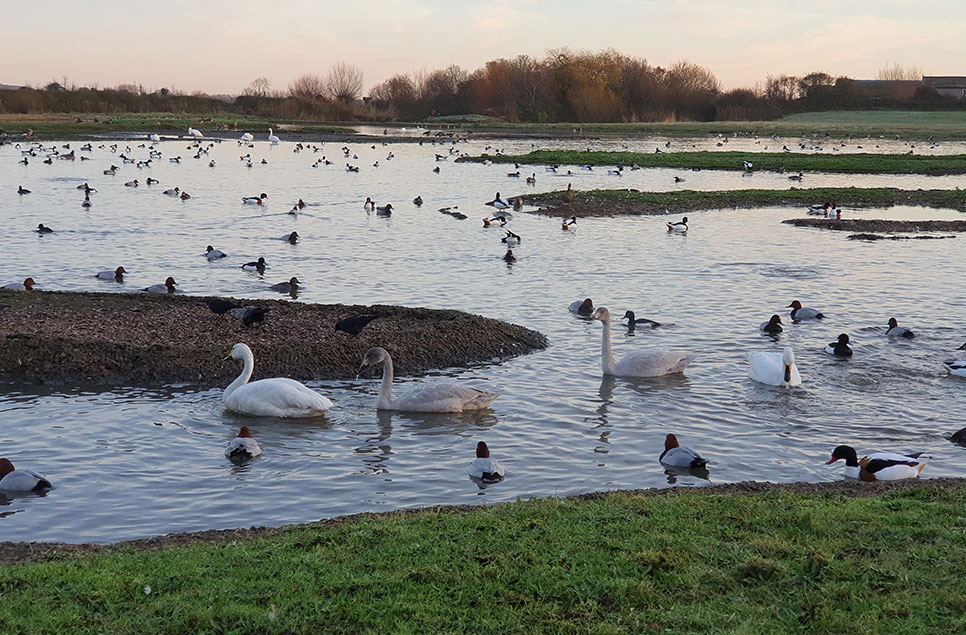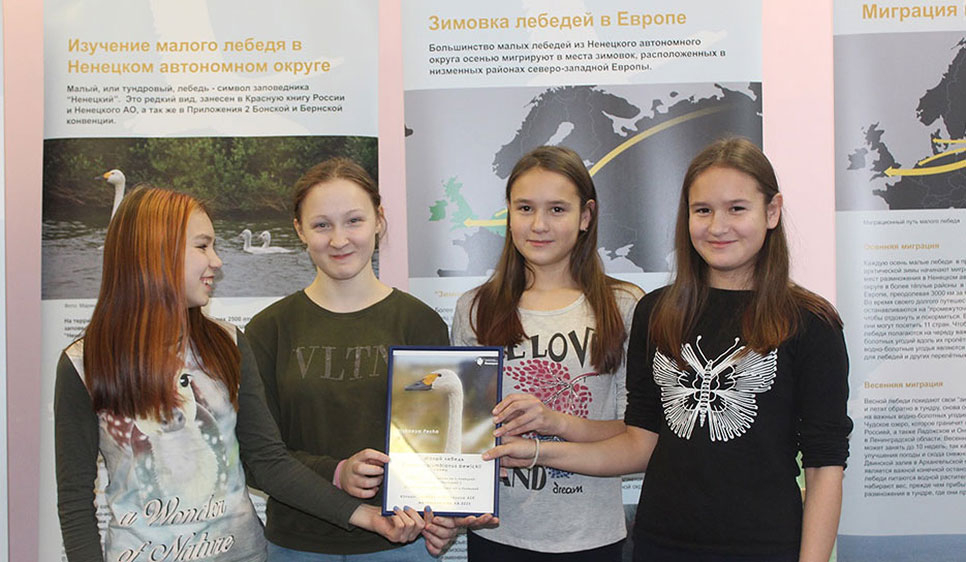Au revoir!
The last five Bewick's swans left on their spring migration over the weekend, bringing to a close what has been another winter packed with excitement, intrigue, romance and sadness.
As soon as the first birds arrived at Slimbridge on 19 October, we were kept eternally entertained by the comings and going on Swan Lake. One of my personal highlights was seeing Winterling casually fly in one afternoon, who at the age of 28 years, broke the record for the oldest swan known to have visited Slimbridge!
 Incredibly, Winterling first visited the reserve as a cygnet in 1982 with her parents Albert and Rachel, and has been a firm fixture here most winters since! She is creaking her way towards equalling the world record for longevity, reached by a ringed bird who was 29 years old when found dead in 1993, so fingers crossed for her safe migrations to and from Russia this year. We were able to catch her in January and attach a green ring coded AGD to her leg, so we hope to hear of her progress soon.
Incredibly, Winterling first visited the reserve as a cygnet in 1982 with her parents Albert and Rachel, and has been a firm fixture here most winters since! She is creaking her way towards equalling the world record for longevity, reached by a ringed bird who was 29 years old when found dead in 1993, so fingers crossed for her safe migrations to and from Russia this year. We were able to catch her in January and attach a green ring coded AGD to her leg, so we hope to hear of her progress soon.
We welcomed back the divorcees, Saruni and Sarindi,
who for the second year running, spent the winter with different mates, confirming their separation. As Bewick's swans form famously loyal partnerships during their lifetimes, mating for life where they can, the divorce and the subsequent re-pairing of both with new mates took us all by surprise.
Our faith in swan loyalties was promptly restored with the touching reunion of Grenoble and Gien, who had been separated during their migration, probably during bad weather. A vigorous courtship dance ensued after Grenoble arrived at Slimbridge two weeks after Gien!
 As we shivered through what seemed like an endlessly freezing December, the swans flooded in on northerly winds in search of warmth and food as they escaped even harsher conditions on the continent. On 30 January, swan volunteer Steve was kept busy with 327 swans, which was the highest daily count recorded on the reserve since 1997 when 393 birds were observed! This certainly challenged our memories as we attempted to remember all of those faces, some familiar, others not so. I was dreaming of swans bill patterns for quite a few weeks!
As we shivered through what seemed like an endlessly freezing December, the swans flooded in on northerly winds in search of warmth and food as they escaped even harsher conditions on the continent. On 30 January, swan volunteer Steve was kept busy with 327 swans, which was the highest daily count recorded on the reserve since 1997 when 393 birds were observed! This certainly challenged our memories as we attempted to remember all of those faces, some familiar, others not so. I was dreaming of swans bill patterns for quite a few weeks!
One of the most spectacular sights of the winter was the huge flocks of Bewick's in and around Welney in Norfolk. Numbers here peaked at 6,210 on 18 January, higher than the average maximum count seen in the area over the past five years (4,565; WeBS). Sadly, good numbers of swans at wintering sites in the UK this winter was more likely to reflect the greater movement of birds west during the cold weather rather than a healthy population.
We were concerned to see that the Bewick's swans had another poor breeding season. Only 10.5% of the 7,275 birds aged across Europe between 16 and 21 December were youngsters (WWT/W. Tijsen). Although this is slightly better than the proportion of juveniles found in Northwest Europe over the past five winters (8.5%), it's still likely to fall below the annual death rate and contribute to a decline in numbers in the total population. The reasons for fluctuations in breeding success are not entirely clear, although conditions on the breeding grounds in Russia are strongly influential (particularly Spring weather conditions and habitat availability there). The body condition of the birds when they arrive at breeding grounds is also important.
The Bewick's swan is of particular conservation 
concern as a steep decline in numbers has taken place since the mid-1990s (Beekman 1997, Delany et al. 1999, Delany & Scott 2006, Wetlands International 2008). The population wintering in Northwest Europe is thought to be sensitive to the impacts of climate and land-use changes, illegal shooting, chemical pollution and infectious disease. A number of factors are likely to contribute to the decline or fluctuation of the population (through fluctuations in annual breeding success and death rates), and these are currently being explored as a matter of urgency in a collaborative study with international colleagues.
 Now that the swans have left, we are eagerly waiting for news of their progress as they venture to arctic Russia: ringed Slimbridge regulars Wolfie, Riddler, Taciturn and Luvari have already been spotted by observers in the Netherlands and Germany. We wish them luck on their perilous journey, breeding success in the arctic and we look forward to seeing them again in the autumn.
Now that the swans have left, we are eagerly waiting for news of their progress as they venture to arctic Russia: ringed Slimbridge regulars Wolfie, Riddler, Taciturn and Luvari have already been spotted by observers in the Netherlands and Germany. We wish them luck on their perilous journey, breeding success in the arctic and we look forward to seeing them again in the autumn.


